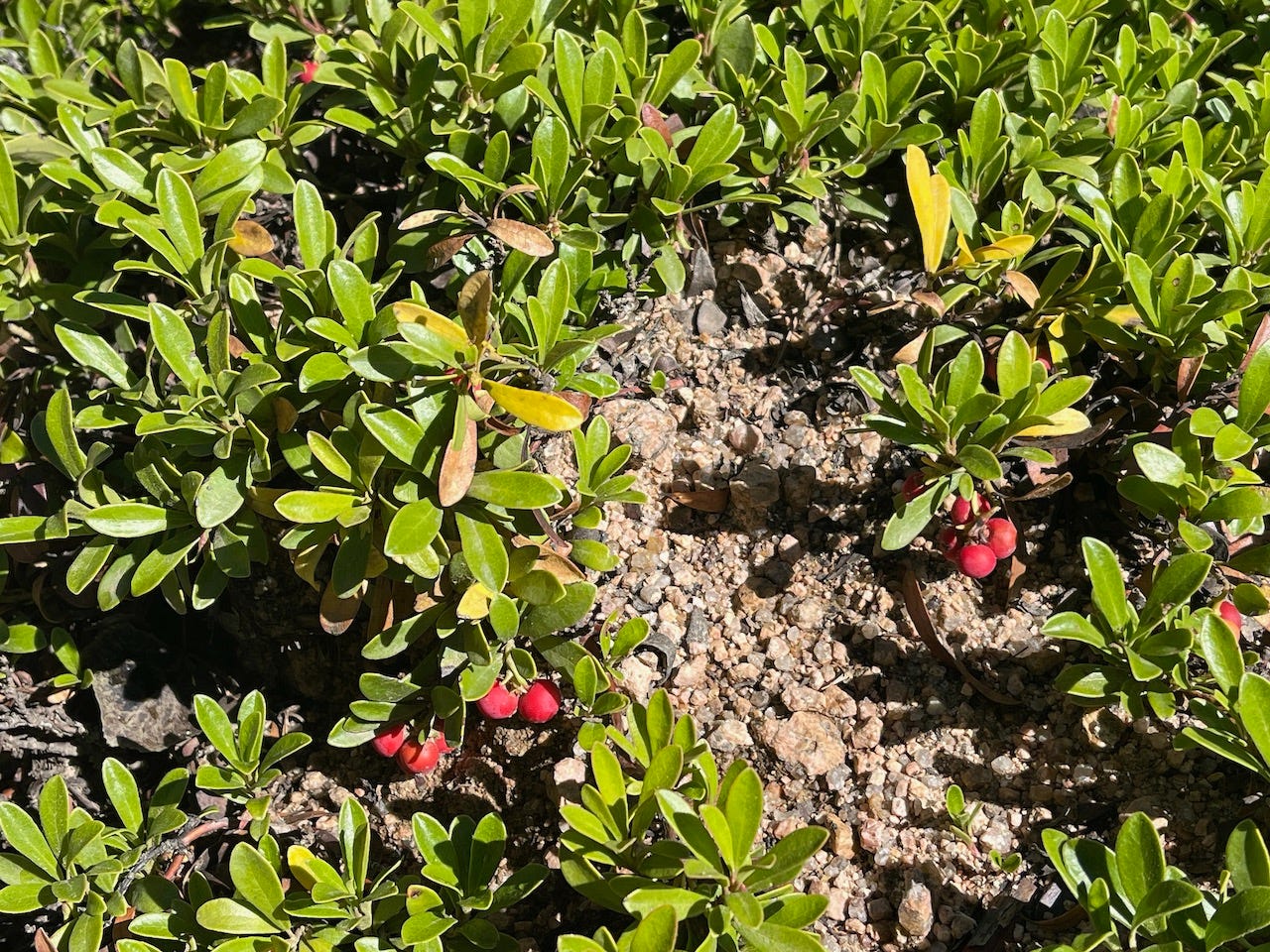Kinnikinnick! Pronounced as it shows: kin•ni•kin•nick
A pervasive ground-cover plant found all across the North American West, Kinnikinnick (Arctostaphylos uva-ursi) is seen by everyone, noticed or not, walked upon by heavy hooves, paws, large and small, and boots, large and small, and still holds its shape. It remains green (an evergreen) through the harshest of winters. Here in the Foothills, it is everywhere on the ground among the Ponderosa Pines.
As with most everything within its natural environment, it is uniquely useful in its place. While unassuming, it feeds grazers like bighorn sheep, mountain goats, deer, elk, and moose. Its flowers are sought by hummingbirds and bees (yay, pollination!). Its bright red berries are consumed by bears (its alternate name is Bearberry), not just in the fall, but especially in the Spring, as the first thing to eat as they wake from hibernation. A wide variety of birds, fox, squirrels, grouse, wild turkey, and other small animals seek out the berries as well. Grouse especially like the roasted fruit after a moderate wildfire. The only animals that notably won’t eat it are domestic livestock, hmmm.
Taste and nutritional loads are somewhat low though, so it is often the last thing to be consumed like that can of soup in the back of your pantry. But this means there is food deep into winter for those deer who look so skinny, you just want to feed them. Don’t feed them though, they have food that their environment has provided already.
For humans, Kinnikinnick is planted as a garden or rock-wall ground cover. The woody roots and stems help with erosion control in sloped areas and it’s a great ground cover for peripheral yard areas that don’t get mowed.
Humans have made use of Kinnikinnick in other ways as well. For Indigenous Peoples, Kinnikinnick was a name for a mixture of dried plants and herbs used for tea or smoking. The name is Algonquian in origin for ‘smoking mixture’. Which came first, the plant or the mixture, it is hard to say. Drinking or smoking the mixture, the recipes varied, and had social, spiritual, ceremonial, and medicinal uses. The leaves do have antibacterial properties and were often used to aid urinary and kidney problems. The felt effect of smoking the mix varies greatly on the concentrations in the mixtures made.
While humans can eat the berries straight, they are mealy and tasteless, so when used, they would be processed and mixed with other ingredients. A hungry pioneer would not turn down the meal though.
A hardy, sustaining plant that looks great and keeps those around it alive. The cycles of ecology and interdependencies of species of plants, animals, insects, and humans are shown once again. Oh, and it makes for lovely street and community names. Take notice on your next walkabout look down and find some Kinnikinnick. You’ll be clicking it on your tongue each time you see it now!
Sources:
https://www.gvsu.edu/itex-aon/kinnikinnick
https://www.gov.mb.ca/agriculture/crops/crop-management/bearberry.
https://www.wildflower.org/plants/result.php?id_plant=ARUV#:~:text=Various%20indigenous%20groups%20in%20California,this%20before%20tobacco%20was%20available.
https://www.wnps.org/blog/plant-profile-kinnikinnick#:~:text=Kinnikinnick%20can%20be%20found%20from,subalpine%20meadows%2C%20and%20coniferous%20forests.
https://www.fs.usda.gov/database/feis/plants/shrub/arcuva/all.html#:~:text=Since%20kinnikinnick's%20low%2Dquality%20fruit,89%2C134%2C148%5D.
https://www.centralcoastbiodiversity.org/kinnikinnick-bull-arctostaphylos-uva-ursi






